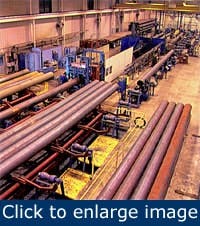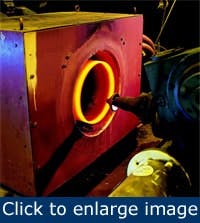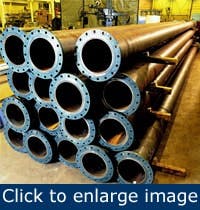Abrasion-resistant pipe exhibits dual personality
Because the outer surface behaves like mild steel, the product can be cut and welded with proper procedure in the field, configured into a variety of fittings and can accept the standard end options of flanges, weld rings and couplings.
When abrasive material is transported through piping, either as pumped slurry or via pneumatic conveyance, the effect on the inner surface is devastating. The abrasive material quickly erodes the pipe from the inside out, which in more extreme cases can result in pipe leaks and even failure, or significant maintenance costs and downtime for pipe replacement.
For industries that regularly transport abrasive material, such as mining, power generation, pulp and paper, food, wastewater, cement, and steel industries, mild steel piping systems are simply not tough enough to stand up to the beating for more than a couple of years.
As a result, engineers are seeking better alternatives to reduce maintenance and prolong system life, at a price point that will not significantly impact the budget.
Abrasion-resistant pipe
Today, there are a variety of “abrasion-resistant” products and accessories that have come onto the market to replace mild steel pipe in high wear areas. Most operate on the premise that when two objects meet, the harder object wins out. As such, products are available in a variety of increasing hardness, measured on the Brinell Scale from A-R steel (200 BHN) through iron cast pipe (up to 800 BHN).
Unfortunately, any product that is very hard throughout the wall thickness is also extremely brittle. This brittleness is unacceptable as piping systems are constantly flexing and moving as a result of pressure surges and spikes, and due to mechanical and physical contact at the facility.
[pullquote]One type of pipe delivers the best of both worlds — an induction-hardened pipe with an abrasion-resistant inner surface that tapers to a strong, yet ductile outer surface.
Manufactured by Port Washington, Wisconsin-based Ultra Tech, this pipe is produced under the Ultra 600 brand. Ultra Tech begins with a steel pipe manufactured to a proprietary chemistry, followed by induction heating, and finally water-quenching the inner surface to create a single-wall pipe.
Ultra Tech’s UT 600 delivers the best of both worlds – an induction-hardened pipe with an abrasion-resistant inner surface that tapers to a strong, yet ductile outer surface.
At 600 BHN, the inner surface of this induction-hardened pipe can withstand most common abrasives, and tapers to a 250 BHN outer surface that is ductile enough to accommodate normal handling during shipment, installation and maintenance. With this proprietary process, pipe can be created in various diameters up to 40 inches in varying lengths and wall thickness.
Because the outer surface behaves like mild steel, the product can be cut and welded with proper procedure in the field, configured into a variety of fittings and can accept the standard end options of flanges, weld rings and couplings.
The company can also produce the Ultra 600 pipe in long radius bends to further reduce wear and eliminate the frequent replacement, repair and associated expense accepted as the norm at the bends and elbows in high wear applications.
Where are the high wear applications?
Abrasive wear is produced by hard particles forced against and sliding along the wall of the pipe. The loss of material is the result of the hard, sharp angular edges producing a cutting or shearing action on the pipe wall.
The hardness of the conveyed product is one of the major indicators of the potential for abrasive wear. Even small percentages of highly abrasive minerals will cause severe abrasive wear. Velocity is another variable that influences wear rate. Doubling the velocity can increase the wear rate by four to six times, depending upon the system arrangement.
{pb}Ultra Tech begins with a steel pipe manufactured to a proprietary chemistry, followed by induction heating, and finally water-quenching the inner surface to create a single-wall pipe.
A short list of specific applications with known high wear rates include the conveyance of rock, stone and waste in mining; the transport of chopped pulp or tree bark (including sand and grit that go with it) in the pulp and paper industry; pneumatic conveyance of sugar, dog food and other abrasive foodstuffs; the transfer of residual ash in slurry by power plants; wastewater sludge systems; and any industry that conveys sand through pipe such as a foundry or glass manufacturer.
A case study — phosphate mining
The Mosaic Company is a leading producer and marketer of concentrated phosphate and potash, two of the primary nutrients used to create fertilizer. The Mosaic Company mines these resources in Canada (potash) and Florida (phosphate).
At its phosphate mining operation in Florida, Senior Pipe Technician John Pillard is charged with selecting the pipe for this extremely abrasive application.
Phosphate is mined using large draglines and then pumped as a slurry mixture of pebble-sized rock, sand and clay through a 20- to 22-inch steel pipeline to a beneficiation plant located anywhere from 1 ½ to 14 miles from the mining site. The slurry is extremely abrasive and will “wear the bottom right out of the pipe, if you don’t have good pipe,” says Pillard.
“The slurry is so abrasive that standard-grade carbon steel pipe just wears out too quickly,” explains Pillard. Instead, the Mosaic Company utilizes a combination of Abrasion-Resistant (A-R) pipe rated at 230 BHN and the induction-hardened Ultra 600.
Much of the A-R pipe was initially installed prior to a merger in 2004, but since then “more of the induction-hardened pipe is taking the place of the A-R pipe simply because it’s a better value,” says Pillard.
At 600 BHN, the inner surface of this induction-hardened pipe can withstand most common abrasives, and tapers to a 250 BHN outer surface that is ductile enough to accommodate normal handling during shipment, installation and maintenance.
According to Pillard, the pipe for the phosphate slurry is primarily where the Ultra 600 is utilized, as well as for a waste discharge pipe that transports large particles such as limestone and even chunks of wood to a waste pit away from the plant.
Getting the most wear for your money
As the senior pipe technician, Pillard says his primary concern is to “get the most wear for your money.”
Pillard estimates that in an extremely high wear area, like the lead dragline in Mosaic’s mining operation, an A-R pipe could wear out in as little as a year and a half. He estimates that the Ultra 600 could easily double that duration in the same location. In a lower (yet still abrasive) wear application, Pillard has seen the induction-hardened pipe last as long as six to eight years.
“You don’t want a pipe that is three times better, but costs ten times as much. That’s not cost effective,” says Pillard. “The Ultra 600 induction-hardened pipe lasts a lot longer than mild steel, with only a moderate price increase.”
For more information, contact Ultra Tech Pipe at 777 Maritime Drive, Port Washington, Wisconsin, 53074; (800) 626-8243; fax: (262) 284-7878; www.ultratechpipe.com.




